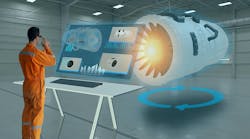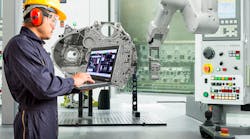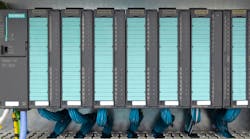The conversation started with a simple question: Does 3D CAD have significant benefits for CNC machine programmers?
After numerous dialogs on the Practical Machinist website (www.practicalmachinist.com) and interviews with software suppliers and end users, it became apparent that implementing a 3D workflow not only benefits machine programmers, it also offers substantial productivity improvements throughout the entire workflow process from pre-quote to out-the door.
The key to understanding how this happens is to step back and look at the entire workflow process rather than focusing on only the designing and machining areas.
3D CAD offers users the ability to look at a part from every possible angle, and to see exactly how one part relates to the other parts in an assembly.
When you combine that ability with instantaneous communication via the Internet, it becomes possible to save significant time and to improve final quality.
Start with a pre-quote for which a customer sends you a 3D file of the part with a request for a quote. Using any one of a number of low-cost 3D CAD viewing software packages, engineers and machinists immediately can look at the part to determine if there will be any problems machining it or special considerations that should be taken into account.
If problems are identified, then using the Internet via an online conferencing application such as Webex and 3D viewers enables the machine shop to notify the customer immediately about those problems so that the customer also can respond very quickly with the necessary changes before the actual quote is made. Days, and perhaps weeks, are saved and mistakes in communication minimized.
Throughout the entire process the use of 3D files and communication via the Internet can dramatically reduce the time it takes to get from quote to purchase order to production.
At the same time, quality problems that might go unnoticed using traditional 2D files and prints are identified and eliminated.
Consider a traditional process in which the shop receives a print that the machinist has to manually convert into G-code. Time can be saved and errors eliminated if, instead of a print, the shop receives a 3D file in a format that is compatible with its CAM software package.
The file comes in, it is fed into the CAM package and out comes the Gcode that is needed to machine the part…more or less. The time to do this is reduced from hours to minutes, and the chances of a programming mistake being made by the machinist are reduced to zero.
Of course that workflow doesn’t always go smoothly.
Incompatibilities between the incoming CAD file and the capability of the CAM package to interpret and transform it can wreak havoc and sometimes require the machinist to completely rebuild the file in a more compatible format.
But that is changing.
As both CAD and CAM packages become more sophisticated, such incompatibilities are disappearing. Even where they exist, doing the necessary workarounds and fixes usually takes less time and creates fewer errors than manually programming the machine.
As far as communicating designs and files, there are a number of options already available and more being put online every quarter.
Web conferencing has become easy and affordable. Three of the main providers of this type of service are Webex (www.webex.com), GoToMeeting (www.gotomeeting.com) and Adobe with its enterprise web conferencing package Accrobat Connect Professional (www.adobe.com). A Google search for “web conferencing” will turn up more service providers.
3D file viewers already abound and more are being introduced regularly. These viewers allow controlled viewing of 3D files by authorized users at little or no cost. Examples include Autodesk’s Design Review and Freewheel (www.autodesk.com), Adobe Acrobat 3D (www.adobe.com), SolidView (www.solidview.com) and Quick 3D (www.quick3d.com). The software you should use depends on the 3D CAD files that you work with.
Specialized quoting software packages also are available. A Google search for “quote software” provides numerous choices. American Machinist has not yet looked at these packages, and cannot help simplify selection at this time.
We have looked at one software package that deals with the entire workflow process from design through delivery.
That package comes from Cimatron North America (www.cimatron.com) Unlike CAD and CAM developers, Cimatron looked at the workflow in a typical machine shop or manufacturer and built its application software to support the entire process.
At the recent American Machinist Machine Shop Workshop, Sam Golan, president of Cimatron North America, described the process for improving machine shop productivity that his company supports. At the heart of that process is identifying the best process and workflow within the shop, streamlining internal and external communications, then implementing an integrated 3D design through manufacturing system.
Golan noted that the Cimatron software was built deliberately to support this process, but that it also is possible to use other software that is available on the market to accomplish the same thing.
It is not necessary to spend a lot of money to implement a 3D system.
The best approach is to start by looking at the shop’s current workflow and supporting processes as a whole, then to figure out how to improve those processes and workflows. After that is done, the next step is to buy the technology that is needed to accomplish the desired objectives.
3D CAD packages are available for less than $1,000. In order to determine if a low-cost package will provide what is needed, it is necessary to know what is needed. That is why you start by analyzing workflow and supporting processes.
In today’s world, if a shop is not using 3D CAD it is at a competitive disadvantage, but to overcome that disadvantage takes more than getting a 3D CAD package. The key is to combine 3D with Internet communications to form a process and service that provides a shop’s customers with real value realized by on-time delivery of quality parts with minimal problems.







